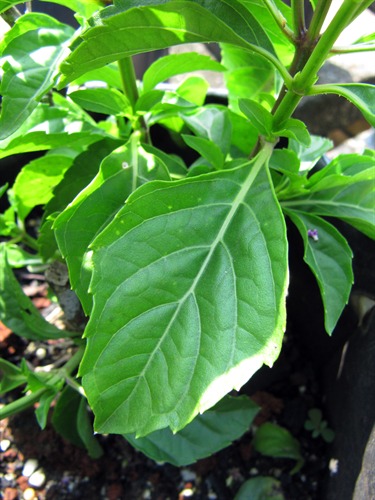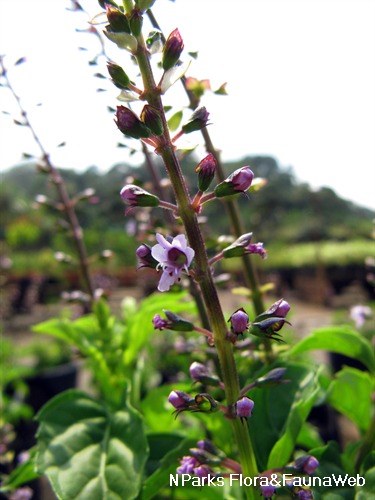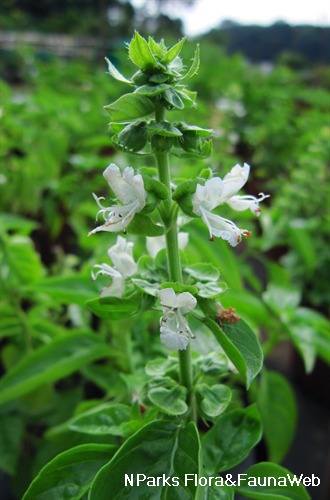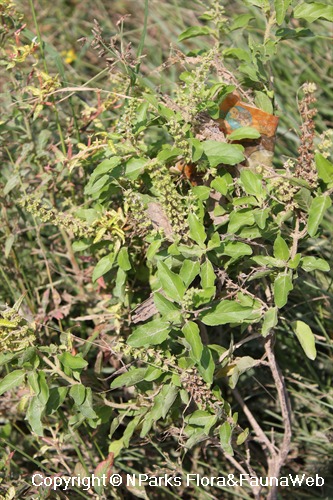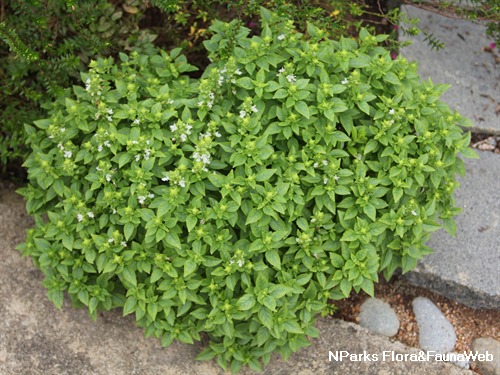
Name
Classifications and Characteristics
| Plant Division | Angiosperms (Flowering Seed Plants) |
|---|---|
| Plant Growth Form | Herbaceous Plant |
| Lifespan (in Singapore) | Perennial |
| Mode of Nutrition | Autotrophic |
Biogeography
| Native Habitat | Terrestrial |
|---|---|
| Local Conservation Status | Non-native |
Description and Ethnobotany
| Growth Form | Perennial herb which resembles plants in the Capsicum genus. |
|---|---|
| Foliage | Glossy, dark green leaves are oblong-elliptic (elongated oval shape) with a toothed leaf margin. |
| Flowers | Small, purple flowers are arranged in long, arching spike inflorescences. |
| Fruit | Dry, indehiscent fruits are known as nutlets. |
| Cultivation | This species requires consistently moist, but well-drained soils. In Singapore, it should be protected from intense afternoon sun. Compared to other basil species and cultivars, it is more disease and pest resistant. It continues to produce leaves after flowering. |
| Etymology | The species epithet is named after Friedrich Sellow (var. Sello) (1789-1831), a German botanist and naturalist. |
| Ethnobotanical Uses | Edible Plant Parts : Edible Leaves Food (Herb or Spice): The leaves of this plant have a flavour which is more mild yet complex compared to other basils. It is used in salads, sandwiches, soups or egg dishes. Medicinal: The leaves are used in folk medicine to treat stomachaches and fever. It is also used as an anti-inflammatory remedy in Brazil. |
Landscaping Features
| Landscape Uses | Small Gardens, Container Planting |
|---|---|
| Thematic Landscaping | Economic Garden |
Fauna, Pollination and Dispersal
| Fauna Pollination Dispersal Associated Fauna | Bee-Attracting |
|---|---|
| Pollination Method(s) | Biotic (Fauna) (Insects (Bee)) |
Plant Care and Propagation
| Light Preference | Full Sun |
|---|---|
| Water Preference | Moderate Water |
| Plant Growth Rate | Moderate |
| Rootzone Tolerance | Moist Soils, Well-Drained Soils |
| Maintenance Requirements | High |
| Propagation Method | Seed, Stem Cutting, Division |
Foliar
| Foliage Retention | Evergreen |
|---|---|
| Mature Foliage Colour(s) | Green |
| Mature Foliage Texture(s) | Glossy / Shiny, Leathery |
| Foliar Type | Simple / Unifoliate |
| Foliar Arrangement Along Stem | Opposite |
| Foliar Attachment to Stem | Petiolate |
| Foliar Shape(s) | Non-Palm Foliage (Elliptical, Oblong) |
| Foliar Venation | Pinnate / Net |
| Foliar Margin | Serrate / Toothed |
| Foliar Apex - Tip | Acute |
| Foliar Base | Cuneate |
Floral (Angiosperm)
| Flower Colour(s) | Purple |
|---|---|
| Flower Grouping | Cluster / Inflorescence |
Fruit, Seed and Spore
| Fruit Classification | Simple Fruit |
|---|---|
| Fruit Type | Indehiscent Dry Fruit , Nut / Nutlet |
| Seed Quantity Per Fruit | Few (1-5) |
Image Repository
Others
| Master ID | 31393 |
|---|---|
| Species ID | 5790 |
| Flora Disclaimer | The information in this website has been compiled from reliable sources, such as reference works on medicinal plants. It is not a substitute for medical advice or treatment and NParks does not purport to provide any medical advice. Readers should always consult his/her physician before using or consuming a plant for medicinal purposes. |

